Ceramic sharpening stones are a popular choice for maintaining and refining the edges of knives and tools. Known for their durability and effectiveness, these stones offer a precise way to achieve razor-sharp results. They are especially favored for their ability to remove minimal material while honing edges to perfection, making them ideal for regular use.
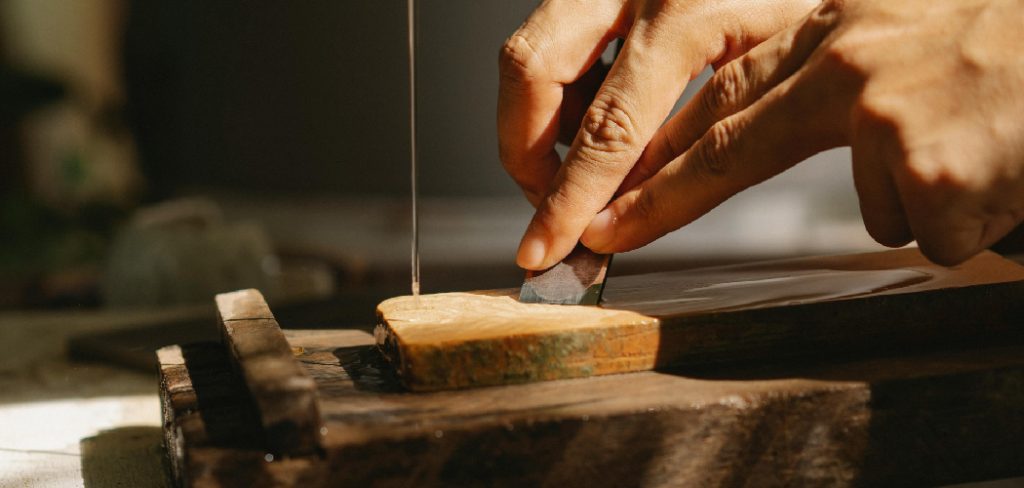
This guide explores the key aspects of how to use ceramic sharpening stones. Whether you’re a professional chef or a home cook, learning to use ceramic sharpening stones correctly can greatly enhance the longevity and performance of your blades.
What Are Ceramic Sharpening Stones?
Ceramic sharpening stones are sharpening tools made from high-quality, hardened ceramic materials. They are designed to fine-tune and perfect the edges of knives, scissors, and other cutting instruments. Unlike traditional whetstones, ceramic stones are often fired at extremely high temperatures, making them dense and less porous.
This construction allows them to provide a consistent abrasive surface that excels at polishing and refining edges. Ceramic stones come in various grits, from coarse options for reshaping dull blades to ultra-fine grits ideal for achieving a mirror-like finish. Their durability and low maintenance make them a reliable choice for both professionals and hobbyists.
Benefits of Using Ceramic Sharpening Stones
Ceramic sharpening stones provide numerous advantages that make them a preferred choice among sharpening tools. One of the primary benefits is their exceptional durability, as they are made from high-quality materials that maintain their structure over time, even with frequent use.
They offer a consistent sharpening experience, allowing you to achieve a fine, even edge on your blades without the need for constant resurfacing. Additionally, ceramic stones are capable of removing minimal material from the blade, which helps preserve the integrity and lifespan of your knives.
Their versatility also stands out, as they are suitable for a wide variety of blade types, including kitchen knives, pocket knives, and specialized tools. Lastly, they require minimal maintenance, making them convenient and cost-effective in the long run. These benefits make ceramic sharpening stones an invaluable tool for anyone who values precision and efficiency in blade care.
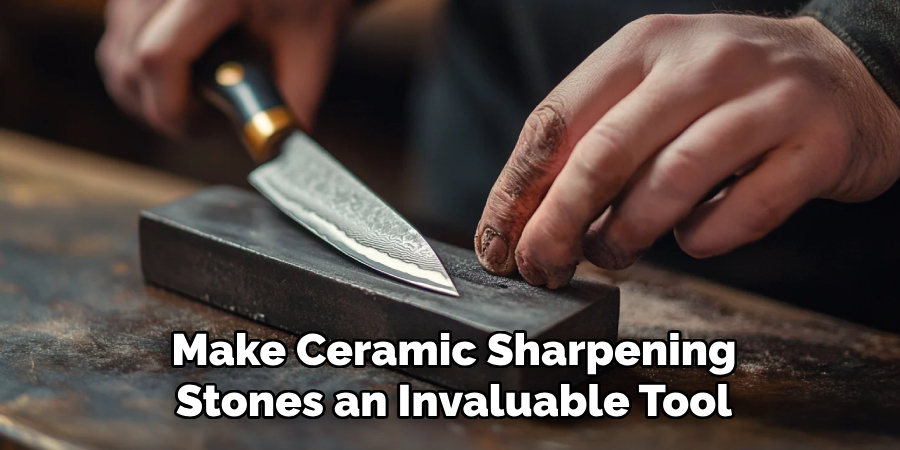
10 Methods How to Use Ceramic Sharpening Stones
1. Select the Right Ceramic Sharpening Stone
Choosing the right ceramic sharpening stone is the first step to a successful sharpening process. Ceramic stones come in various grit levels, ranging from coarse to fine. Coarse grits are ideal for reshaping dull or damaged edges, while fine grits are perfect for honing and polishing.
Some stones have a dual-grit design, offering both functions in one tool. Select a stone that matches your sharpening needs, and ensure it is large enough to accommodate the size of the blade you are sharpening.
2. Clean the Blade Before Sharpening
Before sharpening, ensure that the blade is clean and free from debris, grease, or residue. A dirty blade can transfer grime onto the stone, reducing its effectiveness and potentially causing uneven sharpening.
Use a mild detergent and warm water to clean the blade, then dry it thoroughly with a soft cloth. This step helps maintain the quality of both the blade and the ceramic stone.
3. Set Up a Stable Work Surface
A stable work surface is crucial for safe and effective sharpening. Place the ceramic stone on a non-slip mat or a dedicated sharpening stone holder to prevent it from moving during use.
If your stone doesn’t come with a base, you can use a damp towel underneath it to create a non-slip surface. Stability not only ensures even sharpening but also minimizes the risk of accidents.
4. Wet the Ceramic Stone if Required
Unlike water stones or oil stones, ceramic sharpening stones can often be used dry, but some models may benefit from light lubrication with water. Check the manufacturer’s instructions for specific guidance.
If water is recommended, lightly spray or sprinkle it onto the surface of the stone. Avoid soaking ceramic stones, as they are typically non-porous and do not absorb water. This step helps reduce friction and enhances the sharpening process.
5. Hold the Blade at the Correct Angle
Maintaining the correct angle while sharpening is critical for achieving a sharp and durable edge. Most knives require an angle between 15 and 20 degrees, depending on their intended use.
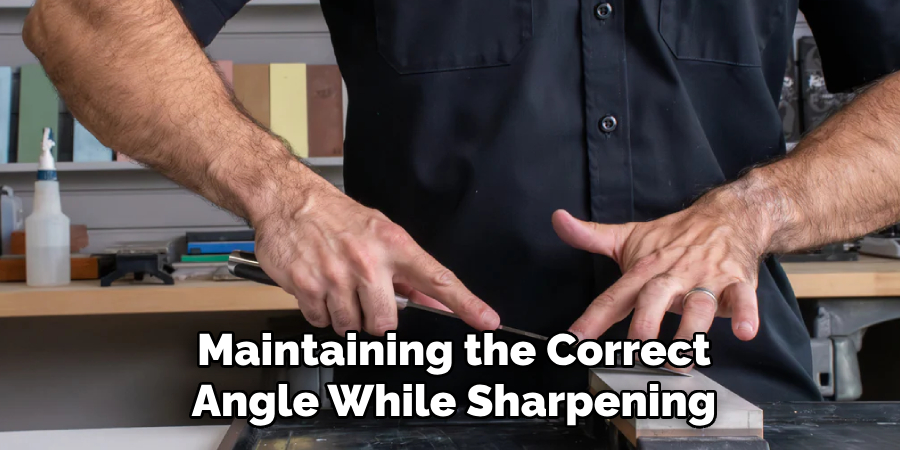
For a consistent angle, consider using an angle guide or practicing on a piece of scrap material before sharpening your primary blade. Maintaining a steady angle ensures an even edge and maximizes the stone’s effectiveness.
6. Apply Even Pressure While Sharpening
When sharpening, use consistent, even pressure to avoid creating uneven edges. Begin by placing the blade on the stone at the desired angle, then move it across the stone in a sweeping motion, starting from the base of the blade and working toward the tip.
Ensure that the entire edge comes into contact with the stone during each pass. Avoid pressing too hard, as excessive pressure can damage the blade or stone and result in uneven sharpening.
7. Sharpen Both Sides of the Blade Equally
To achieve a balanced and symmetrical edge, it’s important to sharpen both sides of the blade equally. Count the number of passes you make on one side, then switch to the other side and repeat the same number of strokes. This ensures that the edge remains centered and consistent. Uneven sharpening can weaken the blade and affect its performance.
8. Progress Through Grit Levels
If using multiple ceramic stones with different grits, start with the coarsest grit to reshape the edge and remove any nicks or imperfections. Once the blade has a basic edge, move to a medium grit to refine it further. Finally, use a fine grit to polish and hone the edge for a razor-sharp finish. Progressing through grit levels ensures a smooth and even sharpening process, resulting in a high-quality edge.
9. Clean the Ceramic Stone Regularly
During sharpening, metal particles and debris can accumulate on the surface of the ceramic stone, reducing its effectiveness. To maintain optimal performance, clean the stone regularly.
Use a gentle abrasive pad, water, and a bit of dish soap to remove buildup. Some stones may require a specific cleaning block or eraser to restore their surface. Keeping the stone clean ensures consistent sharpening results and extends its lifespan.
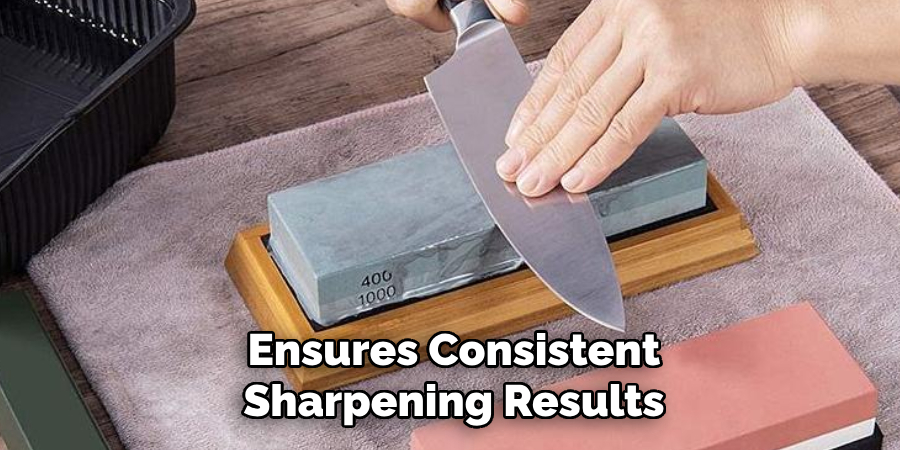
10. Test the Sharpness of the Blade
After sharpening, test the blade’s sharpness to ensure it meets your expectations. One common method is the paper test: hold a sheet of paper vertically and attempt to slice through it with the blade.
A sharp blade should cut cleanly without tearing. Alternatively, you can test the blade on a soft food item, like a tomato, to check its ability to slice effortlessly. If the blade isn’t sharp enough, repeat the sharpening process with finer grit or refine your technique.
Maintenance and Upkeep
Proper maintenance and upkeep of your ceramic sharpening stones are essential for ensuring their longevity and consistent performance. Here are some key tips to keep your sharpening stones in optimal condition:
- Clean the Stone After Each Use
After every sharpening session, clean the ceramic stone thoroughly to remove metal residue and debris. Use warm water and a mild detergent, along with a non-abrasive pad, to gently scrub the surface. Avoid harsh cleaning agents that could damage the stone.
- Dry Completely Before Storage
Ensure the stone is completely dry before storing it to prevent moisture buildup, which can lead to mold or other damage. If water is used during the sharpening process, wipe the stone with a clean, dry cloth and allow it to air dry completely.
- Store in a Safe Location
Store your ceramic sharpening stones in a protective case or in a clean, dry area away from excessive humidity. Keeping the stones in individual sleeves or wrapped in a soft cloth can protect them from chipping or cracking during storage.
- Avoid Dropping or Impact
Ceramic stones are durable but can still chip or crack if dropped or subjected to heavy impact. Handle them carefully, and avoid placing heavy objects on top of them during storage.
Things to Consider When Using Ceramic Sharpening Stones
When using ceramic sharpening stones, there are several factors to take into account to ensure optimal results and maintain the longevity of your tools. Here are some essential considerations:
- Choose the Right Grit for Your Knife
Different knives and levels of wear require different stone grits. Understanding the purpose of each grit level—coarse for repairing and reshaping, medium for refining, and fine for polishing—will help you select the right stone for the job.
- Understand Your Knife’s Edge Angle
Each knife type may have a specific ideal sharpening angle depending on its design and intended use. Research your knife’s specifications or refer to the manufacturer’s recommendations to achieve the best edge geometry.
- Use a Stable Work Surface
Stability during sharpening is crucial for safety and consistent results. Place the sharpening stone on a non-slip base or a damp towel to prevent movement during the process.
- Know When to Replace Your Stone
Over time, even the highest-quality ceramic stones can wear out. Monitor your stone for signs of excessive wear, flatness issues, or reduced efficiency. Replacing a worn-out stone is critical for maintaining sharpening precision.
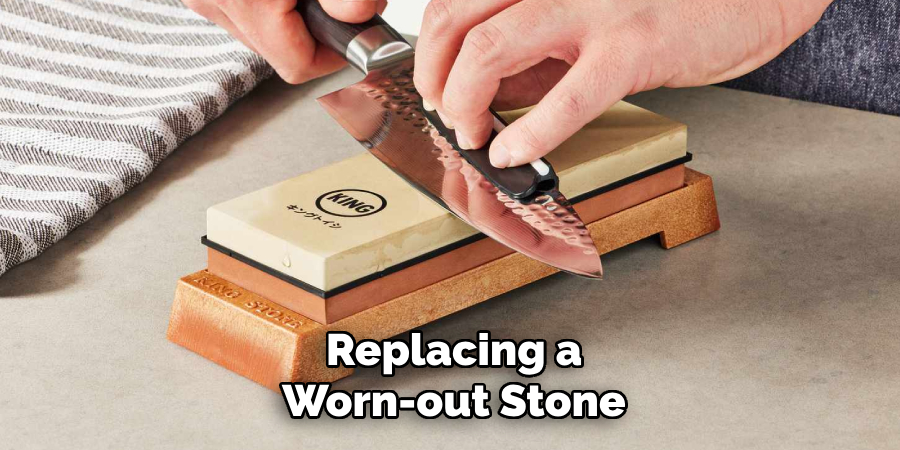
Conclusion
Ceramic sharpening stones are reliable tools for maintaining and restoring the sharpness of blades. By following these ten methods, you can use them effectively to achieve precise and durable edges on your knives and tools. Thanks for reading, and we hope this has given you some inspiration on how to use ceramic sharpening stones!
Specialization:
- Master of wheel-throwing, hand-building, and advanced glazing techniques
- Focus on creating both functional pottery and decorative art pieces
Recognition:
- Celebrated by collectors and art enthusiasts for creating one-of-a-kind pieces that blend artistry with functionality
- Participates in local and national exhibitions, earning accolades for his innovative designs and craftsmanship
Passion:
- Deeply committed to exploring and pushing the boundaries of ceramic artistry
- Continuously experiments with new materials, firing techniques, and artistic concepts to evolve his craft
Personal Philosophy:
- Believes in the transformative power of art, aiming to evoke emotions and connections through his ceramic creations
- Advocates for sustainability in ceramics, using eco-friendly materials and practices whenever possible


